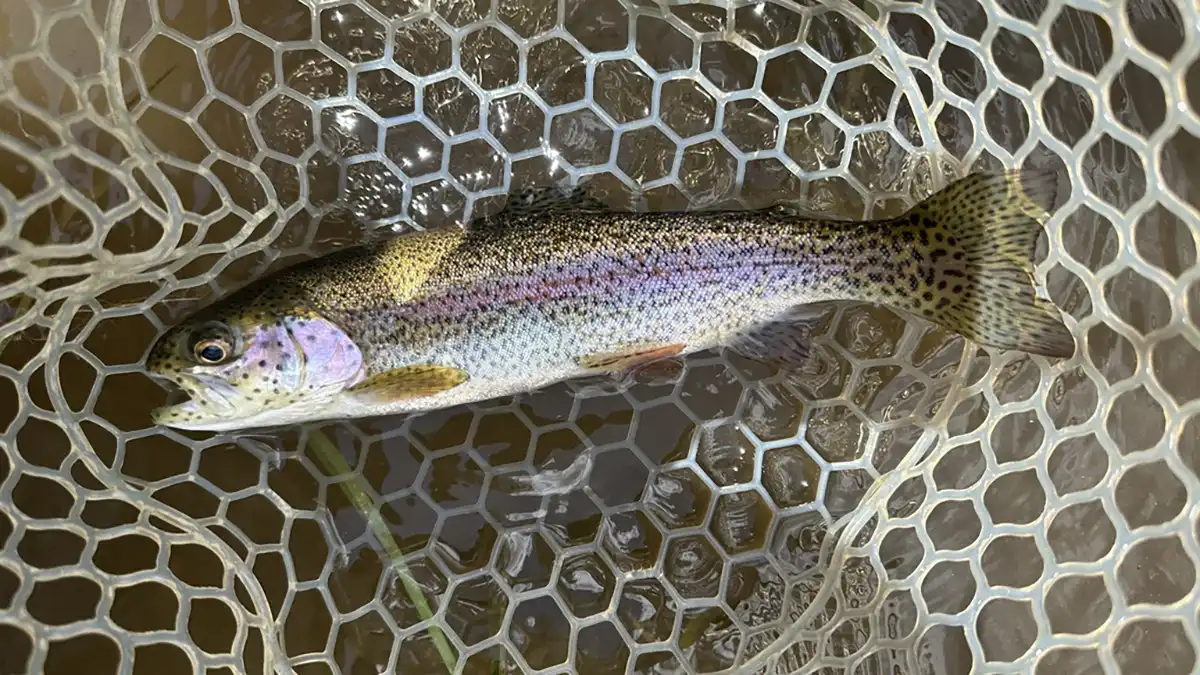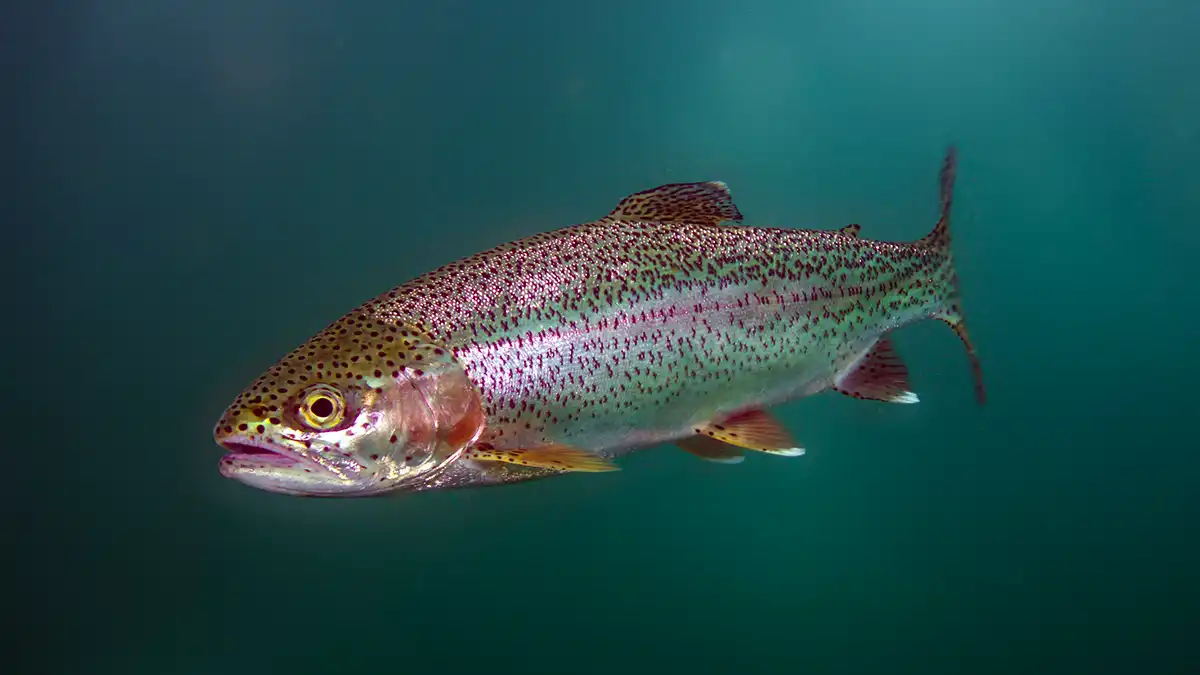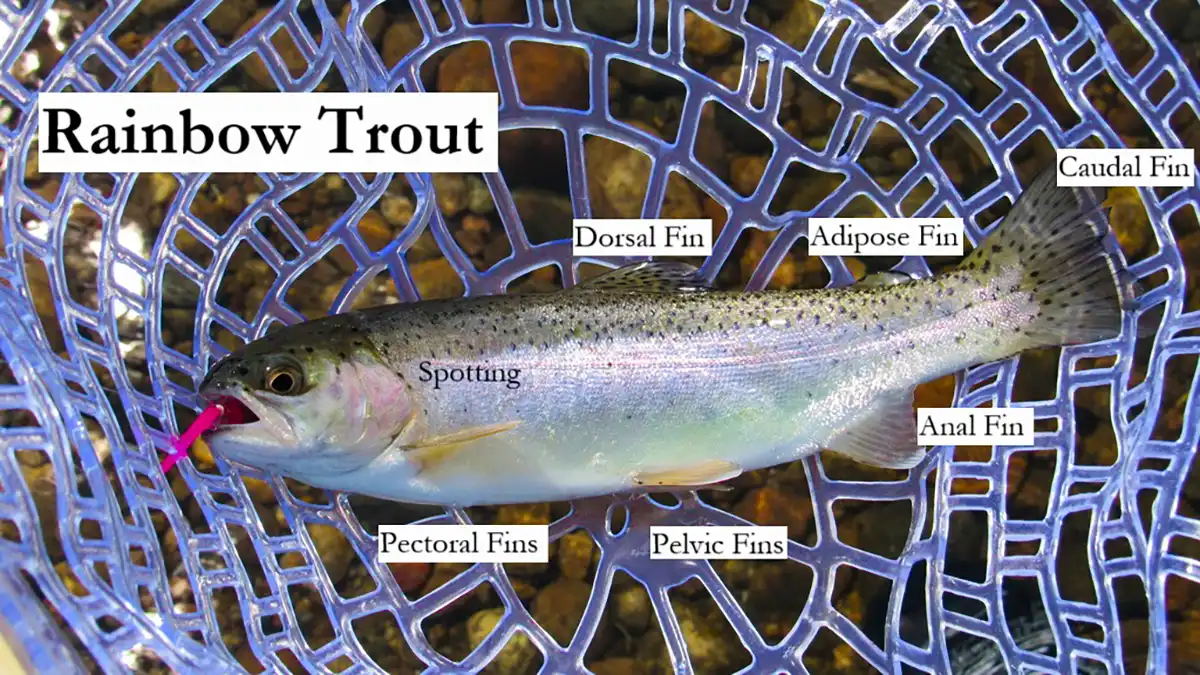Rainbow trout are a beautifully painted fish that is considered the world’s most popular trout species. They are also one of the most stocked trout species worldwide and can be caught on every continent except Antarctica. There are a dozen subspecies of rainbow trout and a separate form called steelhead. If this is news to you or you are curious to learn more about rainbow trout we have compiled everything you need to know about them in this species profile.
RAINBOW TROUT HISTORY
The rainbow trout (Oncorhynchus mykiss) belong to the Salmonidae family, which includes salmon, trout, whitefish, and char species. The family Salmonidae has three genera that include trout, Oncorhynchus, Salmo, and Salvelinus. All members of the genera Salmo, such as the brown trout (Salmo trutta), have origins around the Atlantic ocean. All members of the genera Salvelinus, such as lake trout (Salvelinus namaycush), have origins around the Arctic ocean.
The Oncorhynchus genera contains species with Pacific ocean origins. Currently there are 12 unique species and many subspecies within the Oncorhynchus genus. Species include the apache trout (Oncorhynchus apache), cutthroat trout (O. clarki), coho salmon (O. kisutch), chinook salmon (O. tshawytscha), sockeye salmon (O. nerka), and the rainbow trout. Rainbow trout have been divided into at least 11 subspecies and can have various forms including steelhead. Subspecies include the golden trout (O. mykiss aguabonita), the Kamchatkan rainbow trout (O. m. mykiss), coastal rainbow trout (O. m. irideus), Columbia River redband trout (O. m. gairdneri), and the Baja California rainbow trout (O. m. nelsoni).
The scientific name Oncorhynchus in Greek meaning hook snout or mouth, in reference to the mouth shape of male trout. Mykiss originates back to the original name provided by German taxonomist Johann Julius Walbaum in 1792. Walbaum described a rainbow trout from the Kamchatka Peninsula of Siberia and used a local Kamachatkan name for the fish, mykizha in his description. In 1836 and continuing for 150 years the rainbow trout was moved into the Salmo genera with proposed names of Salmo iridia or Salmo irideus. But in 1989 with advances in genetic analysis and consideration to the Pacific origin of rainbow trout they were eventually moved to the Oncorhynchus genera.
Alternative names for rainbow trout
Rainbow trout and their various forms have several common nicknames including red sides, silver trout, river trout, steelhead, sea-run trout, bow, rainbows, golden trout, albino trout, and pink trout.
RAINBOW TROUT IDENTIFICATION
The body shape and coloration of individual rainbow trout can change based on their environment, resulting in a freshwater form and a saltwater form. The saltwater form is often referred to as a steelhead. Juvenile rainbows regardless of the environment will have 8 to 13 black bars known as parr marks down their sides and are basically indistinguishable for the first couple of years of their life. As they mature the rainbow trout will eventually have coloration differences to help dishearn from ocean or freshwater fish.
Color and marking characteristics
Resident freshwater rainbows have dark olive to bluish green colored backs. Their darker colors slowly fade into a silvery white onto the underside of the fish. They are covered in dark spots that can be prolific along their backs, fins, and side of the body above the lateral line. These spots tend to be mostly uniform in shape but can range from small specks to slightly larger dark circles. One of the most distinct features is the pink to rosy red band that extends from the gill plate back to the anal fin. This feature is where they get the “red-band trout” nickname generated from the western United States. White edged dorsal, anal, and pelvic fins are another typical trait of freshwater rainbows, especially on smaller fish.
Coastal rainbow trout or steelhead tend to be lighter toned. Light green backs and a more silvery side profile is common. The dark spots are generally present but can be irregularly shaped down the sides of the body. When coastal rainbows start to move into freshwater or small tributaries to spawn in the spring their colors usually become more vibrant. The reddish band on their side develops a more vibrant hue and distinct edge. The silvery sides and bellies fade into a grayish color while the greens on their back can also become more prominent.
Color and marking characteristics are helpful but rainbow trout can be positively identified against other species by a few morphological traits. Rainbow trout fins lack spines but they will have rays. The anal fin will have 8 to 13 rays, the dorsal fin will have 10 to 12 rays, the pectoral fins will have 11 to 17 rays, and the pelvic fins will have 9 to 10 rays. The caudal tail will be square shaped with a slight fork. Male and female rainbow trout will have sexual dimorphism between each other with the females having a rounder head with even jaw length. The male will have an elongated head and a protruding lower jaw.
How to distinguish rainbow and cutthroat trout?
The cutthroat trout is arguably the hardest trout species to dishearn from rainbows. Their body color and spotting can be very similar to that of the rainbows and they can even cross breed with each other creating hybrid offspring with markings of both fish.. The cutthroat trout will have solid colored fins, a deeply forked and pointed caudal tail, red to orange linear marks on the lower jaw and in the folds of lower gill plates, and presence of a small tooth patch on the base of the tongue. Rainbow trout will not have the tooth patch, have white margins on their fins, and a squared caudal tail.
See more information here, on how to identify rainbow trout from other types of trout.
RAINBOW TROUT DISTRIBUTION
Rainbow trout are native to cold water tributaries and streams with eventual connectivity to the Pacific Ocean. They could originally be found from the Baja peninsula of Mexico north into Alaska, across the Pacific along the coast of the Kamchatka peninsula of Russia. The United States rainbow trout native population was restricted to Alaska, California, Washington, Oregon, Idaho, and small parts of northern Montana and Nevada.
Rainbow trout are arguably one of the most recognizable and popular trout species, couple this with their ability to thrive and adapt to many environments and it should be no surprise that today they are one of the most widely distributed stocked sportfish species. They have now been introduced into fisheries worldwide and are the most widespread trout species on the planet. Farming of rainbows has taken place since the 1880’s, mainly originating in northern California. Fisheries across the US and worldwide are stocked yearly with farm raised rainbow trout. The largest producer of rainbow trout is now Chile and the fish can be found on all continents except Antarctica. Countries with rainbow trout include the UK, Italy, France, Germany, Denmark, Spain, New Zealand, Chile, Argentina, Australia, South Africa, Japan, and China.
To visualize the current distribution of rainbow trout worldwide we created this interactive map:
RAINBOW TROUT SPAWNING
Most trout and salmon species spawn in the winter months, but rainbow trout spawn in the spring between February and May when water temperatures reach about 40-50℉, in the southern hemisphere this will be in September to November. Migration can be part of the spawning season, with populations migrating upstream to spawn. Ocean based rainbow trout will make much longer migrations upstream compared to populations found in lakes. Lake bound populations migrate into tributary streams or find shallow areas with a hard bottom to spawn.
The male trout typically migrate first and begin to show off vibrant coloration and an elongated bottom jaw. Males will vigorously fight for female attention. The female will create a nest called a redd once she finds a suitable area. The redd is created by clearing all unwanted sediment, silt, and debris to give the eggs a safe depression to be laid in. Once the male is paired with a female, it will defend the redd from potential threats. When the female is ready, she will deposit her eggs onto the redd, and the male will fertilize them. She will lay anywhere from 200 to 8,000 eggs and then cover them up to mature over the next several weeks. The eggs need continuous water flow to provide oxygen into the substrate. After 3 to 6 weeks depending on water temperature the eggs will hatch.
This process is artificially created in fish hatcheries to supplement populations worldwide. Typically hatchery spawning begins with broodstock selection and hormone injections to onset egg and milt production. Eggs may be physically stripped from females or females may lay them naturally on mats. Fertilization can be done naturally or physically depending on the hatcheries’ individual processes. Once eggs are fertilized they are then collected and placed into controlled jars with pure oxygen injection.
Unlike salmon the rainbow trout can spawn multiple times throughout the year and its lifetime. They will migrate into and out of spawning grounds several times throughout their lives. Steelhead spawning is similar, with a longer migration into freshwater and back to saltwater after spawning has concluded.

TROUT SIZE AND LIFESPAN
The rainbow trout first emerge from eggs as alevins at 3/4 to 1-inch in length. Alevin feed on their egg sac for around 2 to 3 weeks before reaching the fry stage. The fry will continue to eat and grow through the fingerling stage around 3 to 5 inches. Males will reach maturity around two years or 10 inches in length and females at three years and 10 to 12 inches in length. Rainbow trout live around 4 to 6 years in the wild but have been known to reach up to 11 years old.
Rainbow trout’s growth rate highly depends on the amount of resources available to the fish. Food availability, water temperature, and dissolved oxygen content all determine how fast a rainbow trout can grow in a given environment. Typically, anadromous rainbow trout living in the ocean grow much larger due to the abundance of food and more consistent conditions. Rainbows in freshwater lakes and streams experience higher variability in conditions and can only grow as much as their environment can provide food. Trout in stream systems may only grow to 4 to 6 inches the first couple year, while a more productive lake system could produce a fish around 12 inches. With the right resources, rainbow trout can grow up to 45 inches long and as heavy as 48 pounds.
In fish hatcheries where water conditions and food is maintained to perfection rainbow trout can reach 10 to 15 inches in one year. Second year growth can be up to 20 inches and 6 to 8 pounds. Most hatcheries can raise 6 to 8-inch rainbow trout for stocking the same year.
RAINBOW TROUT HABITAT
Rainbow trout live in various water bodies, including streams, rivers, ponds, lakes, estuaries, and the open ocean. While some rainbow trout live only in freshwater environments, their anadromous counterparts, steelhead, live in fresh and saltwater environments. Anadromous rainbow will spend 1 to 2 years growing in freshwater after hatching before migrating back to the ocean. They will spend up to 3 years in the ocean before moving back to freshwater to spawn and then can migrate back to the ocean for several years.
Rainbow trout need clean, cold, and clear water to thrive. Adult rainbows can live in water temperatures up to 70℉; however, 50℉ to 60℉ is best for juveniles and optimal trout growth. Trout also need well-oxygenated water to survive. Dissolved oxygen counts of 6 parts per million (ppm) and above are best for trout survival.
Ideal trout habitat consists of many components with riffles, pools, eddies, undercut banks, laydowns, and boulders playing different roles for rainbow trout and their life cycle. Trout utilizes these components for predator protection, energy conservation, food consumption, and/or temperature retention. A clean gravel bottom is also the best substrate for trout to make their redds in for spawning. An environment where rainbow trout can move between these different features is crucial to a thriving population.
In parts of the world where annual survival is not possible there are many fisheries agencies that have created put and take fisheries focused on annual winter stocking of rainbow trout. These systems can be pond, streams, or creeks and often have generous harvest regulations as spring and summer approaches. This ensures that the stocked trout are not wasted when temperatures increase and dissolved oxygen decreases with seasonal changes.
RAINBOW TROUT DIET
Rainbow trout have been known to eat anything they can fit in their mouths. However, the size and age of the fish affect what they prefer, which can impact your trout lure choices. Juveniles eat mostly aquatic invertebrates, such as larval and emergent stages of mayflies, stoneflies, salmon flies, caddis flies, etc. They will also feed on terrestrial organisms such as grasshoppers, beetles, and ants. Larger adult fish will still depend on these insects, especially during the winter months, however, as they become larger, they tend to target larger prey. Small fish, fish eggs, crayfish, larger invertebrates, leeches, and even mice all become important aspects of larger rainbow diets.
Rainbow trout raised exclusively in hatcheries feeding on commercial floating fish food will have a higher preference for surface feeding, at least initially upon stocking. Their feeding preferences can change with time as they adapt to a new environment.
In stream environments, trout can stay mainly stationary just outside faster currents and behind eddies, while in pond or lake environments, the fish are more actively moving hunters. Rainbow trout are generally one of the less picky species regarding other trout and when and where they decide to feed. The opportunistic nature of these fish makes them a fast grower and a sought-after game species. While they mostly prefer dawn and dusk, Rainbows will actively feed almost any time of the day and in open or protected water.
THREATS TO RAINBOW TROUT
Habitat degradation, stream connectivity, and water flow play a large part in the current threats on rainbow trout. Human interaction such as urbanization, logging, road building, mining, etc. all contribute to the degradation of wetland and riparian areas. Poor water quality and rising average water temperatures are side effects of this human interaction and put physical strain on these fish. Dam construction has disrupted migratory routes for spawning.
Poor handling of rainbow trout when sport fishing is also a relevant threat. Knowing how to properly fight, land, and handle a fish, especially larger ones, is crucial when practicing catch and release habits. Keeping fish in the water, handling them with wet hands and plastic coated nets are essential to protecting their skin and fine scales.
Rainbow Trout Facts You Need To Know
- The world record Rainbow Trout was caught by angler Sean Konrad at Lake Diefenbaker in Canada, weighing 48 pounds
- The apache trout is the state fish of Arizona
- The golden trout is the California freshwater state fish
- The steelhead rainbow trout is the state fish of Washington
- Anadromous Rainbow trout or Steelhead have been observed jumping up to 11 feet while climbing waterfalls
- Rainbow trout can accelerate from 0 to 25 mph in one second
- Multiple Rainbow trout in a group are referred to as a hover














